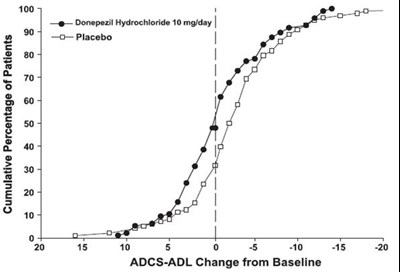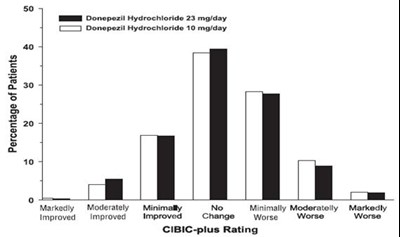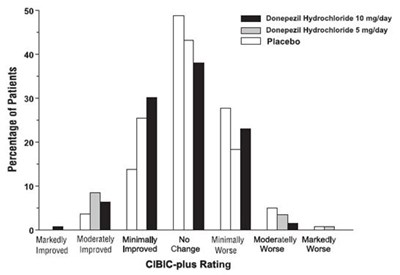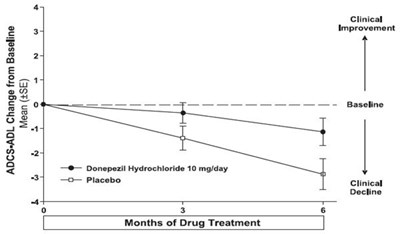Product Images Donepezil Hydrochloride
View Photos of Packaging, Labels & Appearance
- Remedy_Label - Remedy Label
- Figure 1. Time-course of the Change from Baseline in ADAS-cog Score for Patients Completing 24 Weeks of Treatment. - donepezil fig1
- Figure 10. Cumulative Percentage of Patients Completing 6 Months of Double-blind Treatment with Particular Changes from Baseline in ADCS-ADL-Severe Scores. - donepezil fig10
- Figure 11. Time-course of the Change from Baseline in SIB Score for Patients Completing 24 Weeks of Treatment. - donepezil fig11
- Figure 12. Cumulative Percentage of Patients Completing 24 Weeks of Double-blind Treatment with Specified Changes from Baseline SIB Scores. - donepezil fig12
- Figure 13. Frequency Distribution of CIBIC-plus Scores at Week 24. - donepezil fig13
- Figure 2. Cumulative Percentage of Patients Completing 24 Weeks of Double-blind Treatment with Specified Changes from Baseline ADAS-cog Scores. The Percentages of Randomized Patients who Completed the - donepezil fig2
- Figure 3. Frequency Distribution of CIBIC-plus Scores at Week 24. - donepezil fig3
- Figure 4. Time-course of the Change from Baseline in ADAS-cog Score for Patients Completing the 15-week Study. - donepezil fig4
- Figure 5. Cumulative Percentage of Patients with Specified Changes from Baseline ADAS-cog Scores. The Percentages of Randomized Patients Within Each Treatment Group Who Completed the Study Were: - donepezil fig5
- Figure 6. Frequency Distribution of CIBIC-plus Scores at Week 12. - donepezil fig6
- Figure 7. Time Course of the Change from Baseline in SIB Score for Patients Completing 6 Months of Treatment. - donepezil fig7
- Figure 8. Cumulative Percentage of Patients Completing 6 Months of Double-blind Treatment with Particular Changes from Baseline in SIB Scores. - donepezil fig8
- Figure 9. Time Course of the Change from Baseline in ADCS-ADL-Severe Score for Patients Completing 6 Months of Treatment. - donepezil fig9
- Chemical Structure - donepezil str
Product Label Images
The following 15 images provide visual information about the product associated with Donepezil Hydrochloride NDC 70518-4392 by Remedyrepack Inc., such as packaging, labeling, and the appearance of the drug itself. This resource could be helpful for medical professionals, pharmacists, and patients seeking to verify medication information and ensure they have the correct product.
Remedy_Label - Remedy Label

This is a description of Donepezil HCI tablets in 5 mg strength with a quantity of 90 tablets. The tablets are white and round in shape. The usual dosage information can be found in the insert. The tablets were repackaged by RemedyRepack Inc. and the original manufacturer is Rising Pharma, Inc. It is advised to keep the medication out of children's reach and store it between 20-25°C (68-77°F) with excursions permitted to 15-30°C (59-86°F).*
Figure 1. Time-course of the Change from Baseline in ADAS-cog Score for Patients Completing 24 Weeks of Treatment. - donepezil fig1

Figure 10. Cumulative Percentage of Patients Completing 6 Months of Double-blind Treatment with Particular Changes from Baseline in ADCS-ADL-Severe Scores. - donepezil fig10

This is a chart displaying the cumulative percentage of patients showing change in the Alzheimer's Disease Cooperative Study-Activities of Daily Living (ADCS-ADL) scores from baseline after treatment with Donepezil Hydrochloride 10 mg/day and placebo. The chart indicates that a higher percentage of patients treated with Donepezil Hydrochloride showed improvement in ADCS-ADL scores compared to those who received placebo.*
Figure 11. Time-course of the Change from Baseline in SIB Score for Patients Completing 24 Weeks of Treatment. - donepezil fig11

This text provides information on the change from baseline in clinical improvement and decline for patients receiving Donepezil Hydrochloride at doses of 23 mg/day and 10 mg/day over 12 to 18 weeks of drug treatment. The data includes LS mean (SE) values for the clinical outcomes evaluated.*
Figure 12. Cumulative Percentage of Patients Completing 24 Weeks of Double-blind Treatment with Specified Changes from Baseline SIB Scores. - donepezil fig12

Figure 13. Frequency Distribution of CIBIC-plus Scores at Week 24. - donepezil fig13

This appears to be a medication prescription for Donepezil Hydrochloride in two different doses (23mg/day and 10mg/day). The text also contains a rating scale indicating levels of improvement or change in symptoms. The CIBIC-plus Rating scale is likely being used to assess the effectiveness of the medication based on the observed changes in the patient's condition.*
Figure 2. Cumulative Percentage of Patients Completing 24 Weeks of Double-blind Treatment with Specified Changes from Baseline ADAS-cog Scores. The Percentages of Randomized Patients who Completed the - donepezil fig2

Figure 3. Frequency Distribution of CIBIC-plus Scores at Week 24. - donepezil fig3

This text appears to be a report or assessment of patient improvement based on a certain condition or treatment. It includes a scale that ranges from "0" to "3" with descriptions like "markedly improves," "moderately improves," "no change," "worsened," among others. Additionally, there is a mention of a "CIBIC-plus Rating" which might refer to a clinical evaluation tool.*
Figure 4. Time-course of the Change from Baseline in ADAS-cog Score for Patients Completing the 15-week Study. - donepezil fig4

This text appears to be related to a comparison of different treatments for cognitive decline or dementia, possibly with the drug Donepezil Hydrochloride. The evaluation includes a measurement of improvement or decline on the ADAS-cog scale. The document seems to be discussing the effects of Donepezil Hydrochloride 10mg/day, Donepezil Hydrochloride 5mg/day, and a placebo. It mentions a baseline and shows results of clinical improvement or decline. It also references "Works of drug treatment" compared to a placebo.*
Figure 5. Cumulative Percentage of Patients with Specified Changes from Baseline ADAS-cog Scores. The Percentages of Randomized Patients Within Each Treatment Group Who Completed the Study Were: - donepezil fig5

Figure 6. Frequency Distribution of CIBIC-plus Scores at Week 12. - donepezil fig6

This text appears to be a table showing the percentage of patients for different categories such as improved, worsened, or no change while being treated with Donepezil Hydrochloride. The table also includes the dosage of Donepezil Hydrochloride and a placebo. The CIBIC-plus rating is also mentioned in the text.*
Figure 7. Time Course of the Change from Baseline in SIB Score for Patients Completing 6 Months of Treatment. - donepezil fig7

This text provides information on the change from baseline in clinical improvement after 3 months of drug treatment with Donepezil Hydrochloride 10 mg/day compared to a placebo. The mean values and standard errors are obtained for each treatment group.*
Figure 8. Cumulative Percentage of Patients Completing 6 Months of Double-blind Treatment with Particular Changes from Baseline in SIB Scores. - donepezil fig8

This text provides information on the cumulative percentage of patients for Donepezil Hydrochloride 10 mg/day and Placebo treatment groups. It includes data points for SIB change from baseline, showing the distribution of patients across different levels of change.*
Figure 9. Time Course of the Change from Baseline in ADCS-ADL-Severe Score for Patients Completing 6 Months of Treatment. - donepezil fig9

This text provides information on the change from baseline in activities of daily living (ADL) for patients treated with Donepezil Hydrochloride 10 mg/day compared to placebo over a period of 3 months. The data indicates the mean improvement, represented with standard error. This information can be valuable for evaluating the effectiveness of Donepezil in enhancing ADL in a clinical setting.*
* The product label images have been analyzed using a combination of traditional computing and machine learning techniques. It should be noted that the descriptions provided may not be entirely accurate as they are experimental in nature. Use the information in this page at your own discretion and risk.
